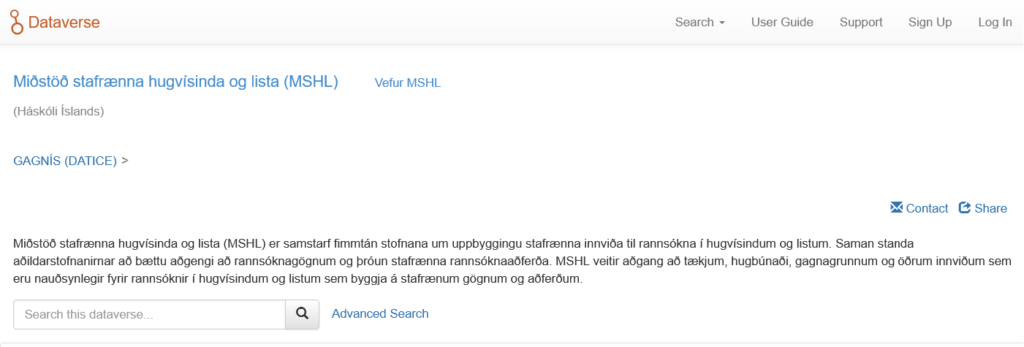Before deciding where and how to deposit or share research data, it is essential to understand the nature of the data itself. Recognizing whether data are living or static helps determine the most appropriate approach for archiving, sharing, and maintaining them responsibly over time.
Living data are datasets that evolve over time. New entries are added, corrections are made, or analyses are updated as the research progresses. These data require storage solutions that support version control, collaborative access, and continuous updating, such as institutional repositories with dynamic data management capabilities or platforms.
Static data represent a finalized and stable version of a dataset that will no longer change after publication. These are best stored in trusted, long-term repositories.
Maintaining living data
Icelandic Research e-Infrastructure – IREI
The Icelandic Research e-Infrastructure (IREI) Link aims to establish a powerful, scalable, and unified IT platform to support scientific research in Icelandic universities and research institutions.
IREI provides researchers with consultancy, secure data storage, high-performance computing (HPC) capacity, and data-sharing solutions. The infrastructure is designed to meet the growing computational and data management needs of research projects in all disciplines, from the humanities to the natural sciences.
The development of IREI is divided into two main phases:
Startup Phase
This phase focuses on the procurement and implementation of the core infrastructure, including HPC hardware, large-scale storage systems, backup and data-sharing solutions, and robust firewall security.
Expansion Phase
Once the core systems are established, the next phase will add additional resources, such as enhanced computing power, extra HPC nodes, increased storage capacity, servers, and network infrastructure. This phase will also introduce integration with external systems and cloud service providers, enabling seamless data sharing and interoperability with other research infrastructures.
Contact
Guðmundur H. Kjærnested, University of Iceland, Director of the Division of Information Technology (ghkjaerne@hi.is)
Depositing static data
Why archive data in an online repository instead of publishing it?
Archiving data resulting from a research project provides an additional output besides many other research outputs. Archived data can complement publications and provide the baseline data used for publications.
DATICE – The Icelandic Research Data Service
DATICE (Icelandic GAGNÍS) is the official service provider for the Consortium of European Social Science Data Archives (CESSDA-ERIC) in Iceland. Its main objectives are to maximise the use of research data in Iceland, to ensure free and wide access to the data and its long-term preservation. The service is a collaboration between all Icelandic universities and is set up to ensure open and free access to scientific data for the research community, the media and the general public. DATICE’s data is archived using the Dataverse repository system developed by Harvard University. Dataverse is an open-source software that was designed specifically to provide open access to scientific data in accordance with the FAIR principles.
DATICE was established as a response to the growing demands of the international scientific community for the open dissemination of publicly funded research data. Its establishment is in line with the HI26 policy of the University of Iceland. DATICE works in accordance with international standards, including the FAIR Principles.
The CDHA Dataverse
CDHA has its own Dataverse repository for depositing, preserving, and sharing arts and humanities research data.
In the repository, you can:
- Download data files
- Access accompanying documentation, which provides context about the design and implementation of the original study
- View rich metadata
The datasets are subject to the Creative Commons license CC BY-NC-SA 4.0, which grants the right to use, share and customize the data.
What type of data does DATICE accept?
DATICE gives access to research data in a broad sense, including material from surveys, interviews, tests, and focus group studies. Data can originate from all academic disciplines. Currently, DATICE primarily focuses on quantitative datasets, but archiving and sharing of qualitative data will be possible in the future.
DATICE accepts a wide range of data file formats.
How to submit data to DATICE
Researchers can deposit their datasets in DATICE by following these steps:
- Prepare the data files
The depositor ensures that the dataset is clean, follows the FAIR principles and that all direct personal identifiers have been removed. - Confirm data ownership
The depositor verifies ownership of the dataset or provides a data ownership transfer agreement. - Provide metadata and documentation
The depositor provides a detailed description of metadata of the dataset and provides the necessary documentation. Guidance and support are available from DATICE throughout the process. - Submit data and documentation
The depositor sends the completed information form, data files, and accompanying documentation to DATICE for review. After receiving feedback, the depositor makes any required revisions or authorizes DATICE to make the necessary adjustments. - Select access conditions
The depositor and DATICE determine the appropriate access level for the dataset (e.g., open or restricted access). - Sign the licensing agreement
A formal licensing agreement is signed. - Publication
DATICE finalizes and publishes the dataset in the Dataverse repository and assigns a DOI (Digital Object Identifier). The DOI is then shared with the data owner(s) for citation and reference.
Contact
Kjartan Ólafsson, specialist and head of data management (kolafsson@hi.is)
Katrín Lísa L. Mikaelsdóttir, project manager at CDHA and data curator of the CDHA Dataverse (kll@hi.is)
